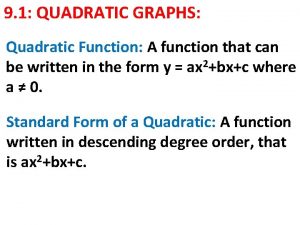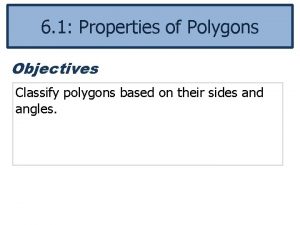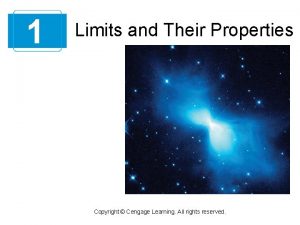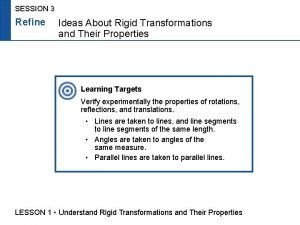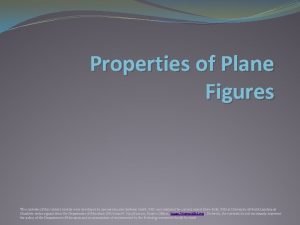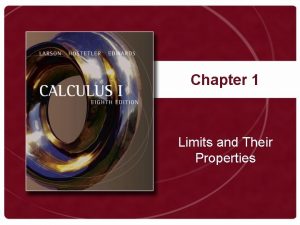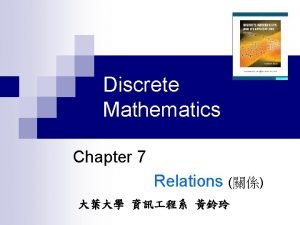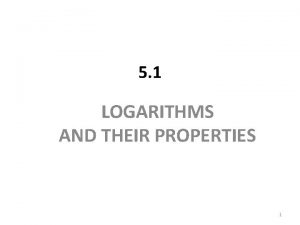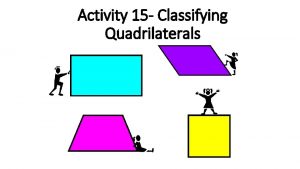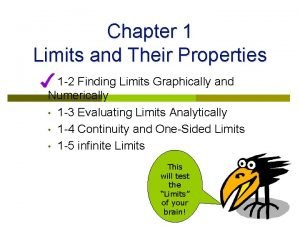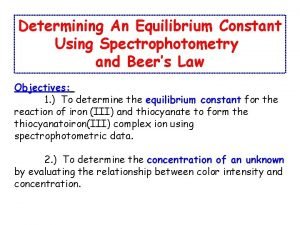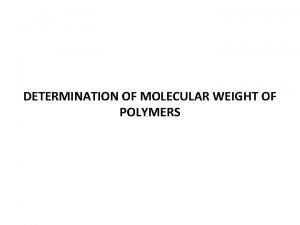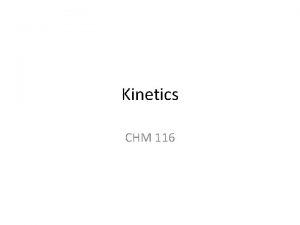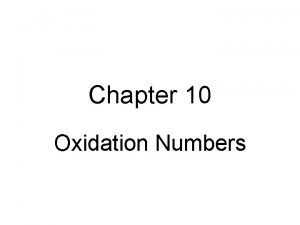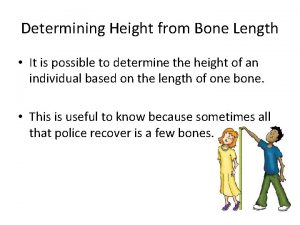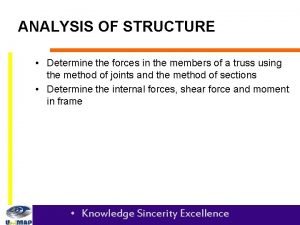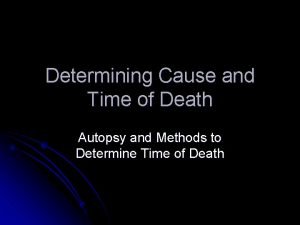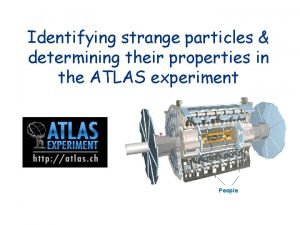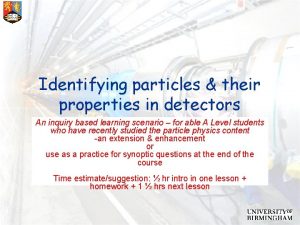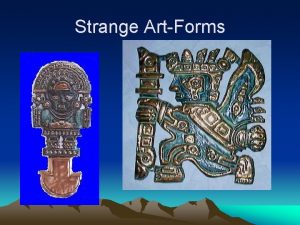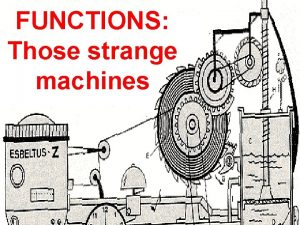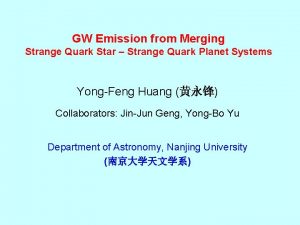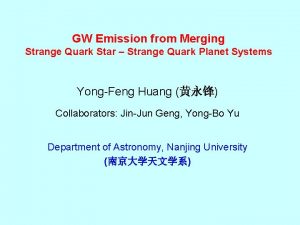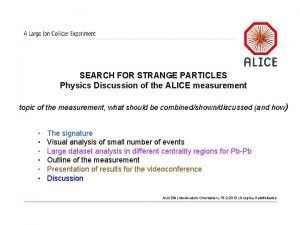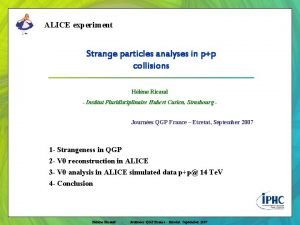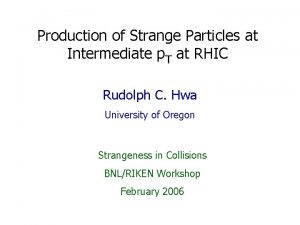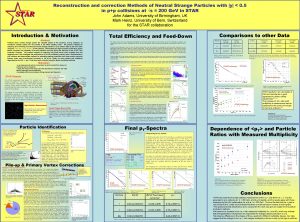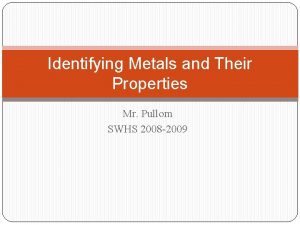Identifying strange particles determining their properties in the
















































- Slides: 48

Identifying strange particles & determining their properties in the ATLAS experiment People

Particles in ATLAS In a particle collision in ATLAS, a large number of particles are produced. Which are they, and how are they constructed?

Many are constructed of quarks and antiquarks

Quarks make up the Hadrons • Baryons - made up of 3 quarks eg protons & neutrons • Mesons - made up of 2 quarks eg pions & kaons

There also leptons ……Which also have their antiparticles but no sub structure – they are elementary

Force carriers • The forces that particles experience arise from exchange of force carriers - g photons for electromagnetic forces - g gluons for the strong force between quarks - W & Z for the weak force which explains things like b decay & nuclear reactions in stars

What evidence do we have for this? • Physicists have designed and carried out experiments with: - Cosmic rays – Particles accelerated in particle laboratories • Using more and more sophisticated particle detectors

• The bubble chamber has been a very useful detector to visualise particle collisions and particle decays. • A charged particle passing through the (superheated) liquid causes the liquid to boil along their paths. • A magnetic field causes the particles to bend.

Classical bubble chamber image The observation of a short-lived neutral kaon in a bubble chamber 9

Modern detectors are very complex and rely on advanced electronics & computer technology ½% of the ATLAS members

Detecting particles • Which particles can we detect – are there any we can’t ? • How do we find their - charge - momentum - energy ? • What characteristics do we look for to identify which particle it is?

What are the principles used? • Ionisation of a medium to show the paths of charged particles • Magnetic fields to exert forces on charged particles and so bend their paths – to identify charge and enable momentum to be calculated • Absorbing materials to stop particles and so enable energy to be calculated

Detector homework GOALS: • To learn more about detectors and the characteristics of particle paths in them • To make some observations and measurements

PREPARATION Explore the physics of the ATLAS detector at: http: //atlas. ch/ - Click on “multimedia” and then “how atlas works” and “animated clips” - Particularly Episode 2: http: //www. atlas. ch/multimedia/htmlnc/feature_episode 2. html - Construction of ATLAS in 3 minutes: http: //www. atlas. ch/multimedia/htmlnc/built_in_three_minutes. html - Click on “e-tours” and look at these too. - Study “Physics with ATLAS” report on the Learning with ATLAS portal.

Download the Minerva software at http: //atlas-minerva. web. cern. ch/atlasminerva Read through the introduction and, using the Minerva help and instructions pdf , work through the 5 tutorial examples.

Strange Particle event files • There are four event files on the Minerva event location for the Strange Particle explorations, each containing 20 event files with 25 events in each. • Choose one of the files – Lambda 0. 9 Te. V (real collision data) – Lambda MC 0. 9 Te. V (simulated event data) – V 0 0. 9 Te. V (real collision data) – V 0 MC 0. 9 Te. V (simulated event data) 16

Student feed back Which particles can we detect? Which characteristics do we look for? How are the particles detected?

Which particles can we detect – are there any we can’t ? • Most particles can be detected by various sections of a modern detector • Neutrinos have no charge and very little mass and rarely interact with matter – we detect their presence only by noting “missing” energy & momentum in collisions Typical detector parts

What characteristics do we look for in the particle tracks to identify which particle it is? • Charged particles, like electrons & positrons, leave tracks in the tracking chamber (where magnetic fields are also applied to enable momentum measurement) and deposit all of their energy in the electromagnetic calorimeter, where it can be measured. • Neutral particles, like a photon, can deposit energy in the electromagnetic calorimeter, but leave no track in the tracking chamber

……………. • • • Charged particles, consisting of quarks, like protons, leave tracks in the tracking chamber (where a magnetic field is also applied to enable momentum measurement) and deposit their energy in the hadronic calorimeter, where it can be measured. Neutral particles, consisting of quarks, like neutrons, also deposit energy in the hadronic calorimeter, but leave no track in the tracking chamber Muons pass through all the detector layers, leaving tracks, and depositing very small amounts of energy in all calorimeters. In the muon spectrometer, a large magnetic field is applied which enables momentum measurement.

Interactions of particles with the detectors Summary e+ n leaves no track at all

The particle trajectory and charge • Tracking devices reveal the paths of electrically charged particles through the trails they leave behind. When particles pass through the detector material, they ionise the atoms of the material. The ionised atoms give rise to a feeble electric current. • Most modern tracking devices produce tiny electrical signals that can be recorded as computer data. A computer program then reconstructs the patterns of tracks recorded by the detector, and displays them on a screen. • The charge on a particle is determined by the curvature of its path in a magnetic field

Motion of charged particle in magnetic fields • The direction of the force on the particle is determined by Fleming’s Left hand Rule: The current direction is the direction in which a POSITIVE charge is travelling. For a negative charge, this direction is reversed, which reverses the force direction

This force provides a centripetal force from which we can deduce particle momentum • F = Bqv • F = mv 2 / r ➱ mv 2 / r = Bqv and momentum P = mv = Bqr Hence a particle’s momentum can be calculated from the radius of curvature of its

How do we find the particle - energy? • A calorimeter measures the energy lost by a particle that goes through it. It is usually designed to entirely ‘absorb’ all of the particles coming from a collision, forcing them to deposit all of their energy within the detector. • Calorimeters typically consist of layers of ‘absorbing’ high–density material (lead or steel) interleaved with layers of ‘active’ medium such as a scintillator. .

• Electromagnetic calorimeters measure the energy of electrons and photons as they interact with the electrically charged particles inside matter. e- High energy e- e- g e+ The high energy e- interacts with the absorbing material, producing a shower of a large number of low energy e-, e+, g. The numerous low energy particles pass into the active material, ionising atoms. The created e- are attracted towards copper electrodes, where the charge is measured. From this, the original energy of the high energy ecan be calculated • Hadronic calorimeters sample the energy of hadrons (particles containing quarks, such as protons and neutrons) as they interact with atomic nuclei The high energy p interacts with an atomic High energy p p p nucleus in the absorbing plates, leading to a shower of particles. These particles enter a scintillating material, causing it to radiate light. Long fibres carry the light to devices where the intensity is measured and converted to an electric current, from which the energy of the incoming proton is measured.

Gather evidence from observation A K 0 particle produced in a proton-proton collision, and decaying in the Inner Detector of ATLAS

K 0 particle features • Features to determine – The mass – The lifetime – Its decay 28

• Working in groups On the Minerva website http: //atlas-minerva. web. cern. ch/atlas%2 Dminerva/ click on masterclass resources and scroll down to computer set up. Choose a suitable version (depending on class size) and download the sets of events – click save, then right click on saved file and extract all (from the zip file) The Strange Particle event files - the K 0 and L 0 event files - are presently being uploaded, and MINERVA is being modified for this scenario. • Locate the file atlantis. jar inside the Atlantis. Java. Minerva folder. Double click this file and MINERVA will begin, as long as you have a recent version of Java installed, version 1. 5 or later. If you need Java installing please go to www. java. com and download the software from the website. The default events are events which are shown in the introductory slides. To display the events of a given group, go to File (upper left corner of the right panel), then click on Read Events Locally, select the minerva file from where you have saved it, select the events folder and then the group you want to display, and click Open.

……. • Print off the Instructions for Atlantis, Summary sheet and Overview sheet in the paperwork section on this page. • Each group takes a sample of 25 events from the Minerva web site and identifies the events within this set that possibly show the decay of a K 0 particle • For each such event, calculate the invariant mass of the K 0 particle and determine its lifetime

Exploration hints • Preparation of the event display (Data tab, In. Det tab and Cuts tab might already be set at start-up) – “Data” tab – Click “Data” tab and under “Status”, then “In. Det” and tick “Track Collection”, “Space Point” and “Rec. Vertex”. – “In. Det” tab – Make the collision point (primary vertex) and the decay points (secondary vertices) well visible by clicking on “In. Det” tab, then “Rec. Vertex” and set the “Symbol size” to 7. Tick “Force symb” to see vertex also on top display. 31

Exploration hints cont. • “Cuts” tab – Set p. T to > 0. 5 Ge. V (p. T is the momentum in the direction at right angle to the colliding beams). Tick the box, and highlight the number. Enter the new number and do “Return”. This removes quite a few tracks and makes it easier to explore the event. – Set z 0 < 20 cm (z 0 is the z coordinate of the primary vertex and should be rather close to 0) and d 0 Loose to < 4 cm (d 0 is the distance the track misses the primary vertex) – The d 0 cut can be used during the exploration of the event. Normally require d 0> 0. 5 mm. This focuses the interest on the particles from secondary vertices. Note that this cut can sometimes also remove a track from the secondary vertex. By removing the cut, all the tracks from the primary vertex are also seen. 32

Exploration hints cont. • Exploration – Use both display projections to inspect primary and secondary vertices close to the collision point, typically within 40 cm from the collision point. Use the zoom facility to focus on that part of the detector. Use the information from both views as some tracks and vertices are easier to observe in one of the views. Sometimes the vertices are somewhat displaced from the real vertex. The best is to complement the display with your own pattern recognition capacity • During the exploration of the event, it is useful to switch from including and excluding the d 0 cut to see tracks that come from the primary and the secondary vertex respectively. 33

Special relativity • High energies, several Ge. V per particle • High speed, close to c, speed of light • Need to use Special relativity – Albert Einstein 1905 – Important contributions from Hendrik Lorentz and Henri Poincaré 34

What is invariant mass? ? • The invariant mass, is a characteristic of the total energy and momentum of a system of particles. • It is the same in all frames of reference – it is invariant. • The invariant mass is the mass of the decaying particle.

In general…. . using SI units… E 2 = p 2 c 2 + m 2 c 4 where m is the invariant mass or just mass. Energy and momentum must be conserved when the K 0 particle decays into a p+ and a p-. Then : E = Ep+ + Ep- and p = pp+ + ppremembering that p is a vector quantity! Then m. K can be calculated: m 2 = E 2 - p 2 c 2 c 4

Units Particle physicists work with less familiar units that simplify the equation: 2 E = E is measured in Ge. V 2 p + P is measured in Ge. V/c (often just called Ge. V in the software) 2 m m is measured in Gev/c 2 1 e. V = energy gained by charged particle accelerated through a voltage of 1 V 1 e. V = 1. 6 x 10 -19 J 1 Ge. V = 109 e. V 1 Te. V = 1012 e. V

Using these units… 2 m m comes out in in Gev/c 2 when = 2 E - E is measured in Ge. V & 2 p p is measured in Ge. V/c

Once you have identified a K 0 p+ + p- event… • Click on “pick” at the top of the GUI box of the software, then click on the two pion tracks one after the other • The three components of the momentum will be displayed. • Calculate the invariant mass of the original K 0 particle in each case: m. K = [ (Ep+ + Ep-)2 - (px p+ + px p-)2 - (py p+ + py p-)2 - (pz p+ + pz p-)2 ]1/2 An excel spread sheet could be designed to do this

Estimating the K 0 mass • Explore the K 0 events, and determine the mass from the momenta of the two pions. • Repeat it for each K 0 particle • Make a histogram of the measured values, and determine the average mass of the K 0. • Estimate the uncertainty. 40

The lifetime • Most particles are unstable. • How long they live depends both on their lifetime and on their speed relative to the observer, that is us. • The lifetime we observe is the particle lifetime at rest multiplied with the gamma factor (also called the Lorentz factor) • The gamma factor, g = 1/(1 -v 2/c 2)1/2 • The gamma (or Lorentz) factor shows up ”everywhere” in special relativity. 41

Estimating the lifetime • Explore the K 0 events, and determine the decay distance, the distance from the collision point to the decay point. • Determine the speed of the K 0 particle • It is often rather close to c, the speed of light. • Determine the lifetime of each K 0 particle, divided by the gamma factor • Make a histogram of the measured values, and determine the lifetime of the K 0. 42

The exponential decrease of the measured lifetime • The measured lifetime of a particle follows an exponential curve given by: – N(t) = No e-t/t – Which describes the number of particles found at times t for a lifetime of t. t is the measured lifetime divided with gamma, the Lorentz factor. – Plotting the number of measured particles with a lifetime t on a logarithmic plot makes it rather easy to determine the particle lifetime. – However, a complication is that the detection efficiency varies as a function of time, and that has to be corrected for. – Without corrections, an average value of the measured lifetimes give an approximate value (order of magnitude) of the lifetime. 43

Collating and discussing results • Groups come back together and tabulate values of mass and lifetimes calculated for the K 0 particles • A histogram of frequency against mass is plotted • A histogram of frequency against lifetime is plotted • Discussion of whether the K 0 is positively identified and to what accuracy

Discussion of measurement technique • The K 0 particle decay can be “seen” in the detector • The decay of very shortlived particles can not be seen in the detector • Can the same technique still be used? • Which complications could there be to use the technique for “invisible”, very shortlived particles?

Discussion of the results • What is your best estimate of the mass of the K 0 particle? • What could the uncertainty be due to? • What is your best estimate of the lifetime of the K 0 particle? • Discuss ways to determine the lifetime more correctly and more precisely. • What could the uncertainty be due to? • How far would the K 0 particle typically move if the gamma factor is 1? 46

K 0 particle and antiparticle • The K 0 particle and the K 0 antiparticle are different particles – The K 0 is composed of an s quark and a u quark – The K 0 (the anti K 0) is composed of an s quark and an u quark – The K 0 and the K 0 are different particles as they are composed of different quarks 47

Lifetime reconstruction 48
 Adjective
Adjective Whats an adjective clause
Whats an adjective clause Information essential
Information essential Dispersed system
Dispersed system Flocculated and deflocculated suspension
Flocculated and deflocculated suspension Three subatomic particles and their charges
Three subatomic particles and their charges Properties used to identify substances
Properties used to identify substances Physical properties of ice cube
Physical properties of ice cube Extensive vs intensive
Extensive vs intensive Relations and their properties
Relations and their properties 9-1 quadratic graphs and their properties
9-1 quadratic graphs and their properties Anthanides
Anthanides Properties of cartridge paper
Properties of cartridge paper Identify type of polygon
Identify type of polygon Inner transition metals
Inner transition metals Investigating graphs of polynomial functions
Investigating graphs of polynomial functions Limits and their properties
Limits and their properties Property of solids
Property of solids Understanding rigid transformations and their properties
Understanding rigid transformations and their properties Classification of waste according to their properties
Classification of waste according to their properties Nitrogen group
Nitrogen group Investigating graphs of polynomial functions
Investigating graphs of polynomial functions Plane figures and their properties
Plane figures and their properties Chapter 1 limits and their properties
Chapter 1 limits and their properties Relations and their properties
Relations and their properties Chapter 17 overview elements and their properties
Chapter 17 overview elements and their properties Chapter 1 limits and their properties
Chapter 1 limits and their properties Relations and their properties
Relations and their properties Log(a+b)
Log(a+b) Quadrilaterals flow chart
Quadrilaterals flow chart Chapter 1 limits and their properties
Chapter 1 limits and their properties Determining ionization energy
Determining ionization energy Determining customer needs
Determining customer needs Constant
Constant System analysis and design kendall
System analysis and design kendall Osmometry molecular weight determination
Osmometry molecular weight determination Rate determining step
Rate determining step Personality feasibility
Personality feasibility Analyzing business transactions worksheet answers
Analyzing business transactions worksheet answers Teacher twins@2014
Teacher twins@2014 Oxidation number rules
Oxidation number rules Length it
Length it A good layout requires determining
A good layout requires determining Polar vs nonpolar
Polar vs nonpolar Determining zero force members
Determining zero force members Do not use key signature
Do not use key signature How to determine the rate determining step
How to determine the rate determining step Methods for determining time of death
Methods for determining time of death Determining optimal capital structure
Determining optimal capital structure










